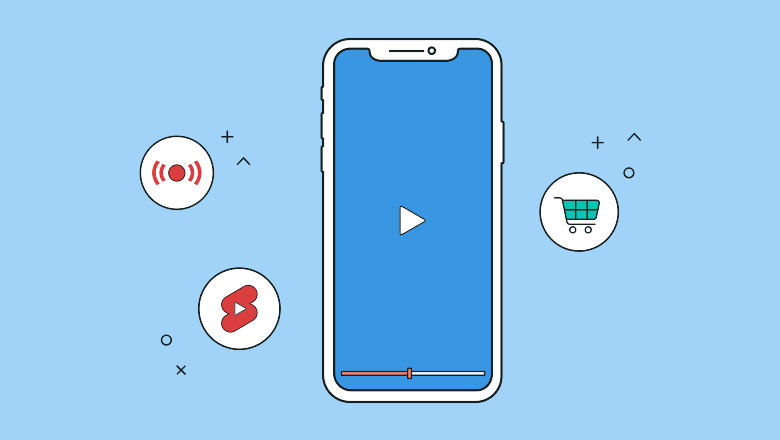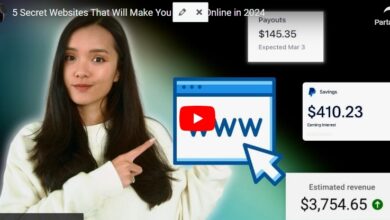9 YouTube trends for your content strategy in 2022
More than half of consumers anticipate using YouTube in the coming year, trailing only Facebook, according to the latest Sprout Social Index™. It’s also the second-most visited website globally, behind Google.
One of the most compelling reasons for marketers to incorporate YouTube into their strategies is that a huge number of people spend a great deal of time there. In the US, 62% of YouTube users access the platform daily where they spend an average of nearly half an hour consuming content.
So what’s hot on YouTube in 2022? In this article, we’ll seek to offer insights into nine current and emerging YouTube trends you need to know to fuel your video marketing strategy.
Current and emerging YouTube trends
Yes, YouTube is a jewel in any digital marketer’s crown. But like on all social networks, trends on YouTube come and go. The challenge lies in keeping track of which are on the rise, which are currently making waves, and which are already on their way out. This list will help.
1. Short-form video
Unless you’ve been living under a rock for the last few years, you are probably aware that vertical short-form video is king in the content world. If you yourself are not binging TikTok videos daily, you likely know a Gen Zer who is. Or maybe Instagram Reels are more your speed?
And this movement isn’t a fluke. In fact, consumers prefer short-form video 2.5x more than long-form. With the popularity of TikTok and Instagram, YouTube is now getting in on the action with its newly released feature, YouTube Shorts, which are already garnering 15 billion daily views.
This new mobile-first feature allows the platform to capitalize on the fact that 70% of its viewership comes from mobile devices. For brands, this current YouTube trend provides a great way to get in front of new users and increase your following.
Brand bringing this trend to life: Spotify
Spotify uses Shorts to promote events and promote or repurpose podcast content. To promote their booth at VidCon 2022, the brand published a series of Shorts detailing the environment and the experience for those who could not attend in person.
2. Live videos
Consumers rank live video the third-most engaging content type, according to the Sprout Social Index™. Plus, in an era of social distancing, these real-time videos can help take the place of live events. In 2020, 70% of people watched an event live on YouTube.
Viewers also stick with live videos a whopping 10-20x longer than pre-recorded content. That gives you a lot more time to make an impression. And brands also have the ability to interact with their audiences in real time, building community by asking and answering questions.
Brand bringing this trend to life: Coachella
For example, in 2022, the Coachella music festival live-streamed both event weekends on YouTube. This not only brought the energy of the in-person event to people around the world, but also gave at-home viewers access to exclusive promotions and artist interviews.

3. Social commerce
Social commerce functionality has been a major focus for many of the top platforms over the last few years. It’s been predicted that social commerce will be a $1.2 trillion industry by 2025, and every network is vying for their piece of the pie. Sprout research found that 68% of people have already made a purchase directly via social, while a staggering 98% expected to do so in 2022.
YouTube is no exception. The network continues to expand its capabilities in this new arena. In July 2022, YouTube announced a partnership with Shopify that will make it easier for sellers to manage their products and stores. They have even introduced a new area in the Explore tab that will allow social shoppers to more easily find relevant content.
Another major YouTube video trend, live shopping is also an option for any brands or creators who want to tag their favorite products when they go live.
Brand bringing this trend to life: Sephora
Not all brands are currently taking advantage of the suite of social commerce tools available on YouTube. Those that are, like Sephora, have set up their virtual storefronts to allow customers to browse featured products directly on YouTube.

4. Creator-led content
Here’s the thing. Consumers are never going to trust brand-created content as much as they will creator-led content. Creators humanize brands and offer their own real-world perspectives, which typically come off as less promotional and more engaging.
Good creators understand and connect with their audiences, which in turn, makes those viewers trust them. It comes as no surprise, then, that YouTube audiences are 17% more loyal to top influencers than they are to media companies.
That’s why the creator economy is such a buzzword in the industry today. Brands that want to optimize their social strategies are pouring money into partnerships with key influencers. In fact, a YouTube video posted by a creator could cost brands anywhere from $200 to $425.
Brand bringing this trend to life: Subway
Creator Milad Mirg was a college student working in his parents’ Subway restaurant when he decided to turn the camera on himself while he was making sandwiches and doing other tasks around the shop. His goal was to improve business for his parents’ business during the slow months early in the COVID-19 pandemic. He did a little better than that, though, ushering in a 700% increase in sales from March 2020 to March 2021.
5. Brand storytelling
Consumers like stories. We are more likely to remember and respond to them than mere facts or declarative statements. Brands that use storytelling well connect with their audiences around shared values and experiences. It helps to convey authenticity (another critical brand attribute).
One of the best ways to make sure your brand storytelling hits the mark is by developing it based on voice-of-customer feedback. Using social listening tools to keep track of rapidly shifting consumer expectations and preferences (and deliver upon them) can help your brand stand out among similar businesses.
Brand bringing this trend to life: Yeti
Yeti has built a sizable following on YouTube, many of which subscribed to get access to its fun and offbeat videos. They do a few things really well when it comes to brand storytelling. One entertaining series pits the brand’s coolers against multiple challenges to test their renowned strength and durability—grizzly bears, stuntmen, fireworks and even mother-in-law’s fruitcake.
For brands looking to improve their relationships with their audience, take a page out of Yeti’s playbook by developing a plan to integrate more storytelling into your YouTube channel.
6. Gaming and community content
In 2021, YouTube saw 800 billion gaming-related video views, 90 million hours of gaming livestreams, and more than 250 million gaming videos uploaded.
Even if you’re not a gaming brand, there are lessons to be learned from the popularity of this type of content. People want to engage deeply and connect with others who are interested in the same things they are. While it might seem strange at first to consider watching someone else play a video game (instead of playing it yourself), a Google survey found that “reactions” and “commentary” from YouTube gamers is a major reason people tune in to watch this kind of content.
If you have more than 1,000 subscribers on the platform, you have access to YouTube’s Community tab, which allows you to carve out a dedicated forum for your audience. Think of it almost like a Facebook or Instagram feed within your YouTube channel.
Brand bringing this trend to life: Headlines Barber Shops
Tampa-based barbershop, Headlines, owned by Chris Bossio, has built a community, primarily of other barbers, on YouTube. Chris offers inspiration, education and his own experience to his subscribers, many of whom seek to emulate his career path. Chris uses the forum to keep his followers up to date on the business, and comments on his posts typically range from expressions of admiration to questions about the trade.

7. Relaxing or comforting content
Let’s be honest, over the last few years, many of us have leaned hard into comfort content to take our minds off the negative news cycle. Bridgerton, anyone?
This phenomenon is true on YouTube, too. People are turning to the network for videos that can help them relax or feel comforted. The vast majority (83%) of Gen Z have used YouTube videos to relax while 69% say they return to content or creators that feel comfortable to them.
Whether this means you’re following along with Yoga with Adriene, watching waves roll in on a beach in Bora Bora, or just hanging out with some online friends, YouTube communities can go a long way toward helping us all decompress from the stress of daily life.
Brand bringing this trend to life: Calm
Calm, a brand known for its ability to engender feelings of zen, leverages YouTube in much the same way they do their own app—to produce a state of relaxation and tranquility. Which is obviously something people are looking for these days. Whether it’s a guided meditation or the brand’s unique “sleep stories,” Calm is catering to a growing consumer preference for content that mellows rather than excites.
8. YouTube for the TV
The YouTube app has been available on televisions for quite some time, basically since the advent of Roku. Not to be confused with YouTube TV, which allows subscribers to watch live TV from more than 85 channels, the TV app seeks to replicate the functionality of desktop or mobile YouTube, with both short- and long-form videos at your fingertips.
In December 2020, more than 120 million people watched YouTube on their TVs. As part of its 2022 roadmap, YouTube shared its plans to enhance that functionality, streamline the user interface and make it easier to sync the mobile and big screen viewing experiences.
Many YouTube users engage with videos on their mobile devices while watching the same content on TV. Brands can make the most of this trend by tapping into interactive YouTube features that keep viewers’ attention on your content, particularly long-form and live video.
Brand bringing this trend to life: Sports Illustrated’s Mile High Huddle podcast
Super Chats allow followers to purchase a spotlight in the chat feeds of their favorite brands’ and creators’ livestreams. Pay a few dollars, and your message will stay pinned to the top of the chatbox for up to five hours. Sports Illustrated’s Mile High Huddle podcast takes advantage of this new tool as the hosts engage with fans on the live video version of their show.

9. 360-degree video
Though introduced about seven years ago, 360-degree video is having a moment in 2022. If you’re new to 360-degree video, it works the same as a 360-degree image. Drag your mouse where you want the video to move, with the ability to view in any direction you choose.
In May 2022, Bad Bunny released a 360-degree music video for “Party” on YouTube. Flip it one way and you’re watching serene waves rolling in on a beach; another way, you’ll see the rapper and friends lounging and hanging out under a tropical sun. Imagine being invited to hang out with a famous musician and a small group of his closest friends on a private beach. That’s essentially the experience created with this video.
Nine out of 10 Gen Zers say they watch YouTube videos to feel like they’re in a different place. What can brands take from this? Consumers are looking to immerse themselves in content that is transportive. What elements of your brand would people want to dive feet-first into? Your answer to that question might provide insight into a perfect topic for a 360-degree YouTube video.
Brand bringing this trend to life: Universal Orlando Resort
Universal Orlando Resort uses 360-degree video to provide an immersive view of their rides and experiences. Users can get a bird’s eye view of what it might feel like to jump on the Jurassic World VelociCoaster, hearing the cinematic music playing as you go upside-down through a corkscrew or pivoting around to see the delighted faces of your fellow thrill seekers in the rows behind you.
Respond to (and anticipate) YouTube trends
If you’re serious about making YouTube a major part of your brand’s social media strategy, it’ll be important for you to stay up to date on the most current trends. It’ll defeat the purpose of carving out a presence on the network if you consistently post content that’s outdated or behind the times.
However, there are some types of YouTube content that are fairly timeless and can be folded into your strategy seamlessly. When you’re ready to get started, this article outlines 15 ideas you might consider including in your YouTube strategy.
The post 9 YouTube trends for your content strategy in 2022 appeared first on Sprout Social.






